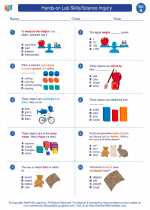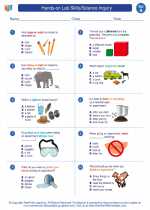Hands-on Lab Skills/Science Inquiry -> physiological adaptations
Physiological Adaptations
Physiological adaptations are changes in the body's systems and processes that occur in response to the environment. These adaptations allow organisms to survive and thrive in their specific habitat. These adaptations can occur at the cellular, tissue, organ, or system level.
Examples of Physiological Adaptations:
- Thermoregulation: Many animals have physiological adaptations to regulate their body temperature. For example, animals in cold environments may have thick fur or layers of fat to insulate their bodies, while animals in hot environments may have mechanisms to dissipate heat, such as panting or sweating.
- Respiratory adaptations: Organisms living in low oxygen environments, such as high altitudes, may have adaptations in their respiratory systems to efficiently extract oxygen from the air.
- Metabolic adaptations: Some organisms have adapted to survive in extreme environments with limited food sources by slowing down their metabolic rate, allowing them to survive on minimal energy.
- Hydration adaptations: Desert-dwelling animals have developed physiological adaptations to conserve water, such as concentrated urine and efficient water reabsorption in the kidneys.
Study Guide:
To better understand physiological adaptations, it's important to study the following concepts:
- The different types of physiological adaptations and their significance in an organism's survival.
- Case studies of specific organisms and their physiological adaptations to extreme environments, such as the camel's ability to survive in the desert or the diving adaptations of marine mammals.
- The role of natural selection in shaping physiological adaptations over time.
- The impact of human activities on the physiological adaptations of organisms, such as the effects of climate change on polar bear physiology.
Understanding physiological adaptations is essential for comprehending how organisms have evolved to thrive in diverse environments and how they continue to respond to environmental changes.
.◂Science Worksheets and Study Guides First Grade. Hands-on Lab Skills/Science Inquiry
Study Guide Hands-on Lab Skills/Science Inquiry
Hands-on Lab Skills/Science Inquiry  Worksheet/Answer key
Worksheet/Answer key Hands-on Lab Skills/Science Inquiry
Hands-on Lab Skills/Science Inquiry  Worksheet/Answer key
Worksheet/Answer key Hands-on Lab Skills/Science Inquiry
Hands-on Lab Skills/Science Inquiry  Worksheet/Answer key
Worksheet/Answer key Hands-on Lab Skills/Science Inquiry
Hands-on Lab Skills/Science Inquiry  Vocabulary/Answer key
Vocabulary/Answer key Hands-on Lab Skills/Science Inquiry
Hands-on Lab Skills/Science Inquiry  Vocabulary/Answer key
Vocabulary/Answer key Hands-on Lab Skills/Science Inquiry
Hands-on Lab Skills/Science Inquiry 

 Worksheet/Answer key
Worksheet/Answer key
 Worksheet/Answer key
Worksheet/Answer key
 Worksheet/Answer key
Worksheet/Answer key
 Vocabulary/Answer key
Vocabulary/Answer key
 Vocabulary/Answer key
Vocabulary/Answer key

The resources above cover the following skills:
EARTH AND SPACE SCIENCE
Earth’s Place in the Universe
Observe seasonal patterns of sunrise and sunset to describe the relationship between the number of hours of daylight and the time of year (e.g., more hours of daylight during summer as compared to winter).